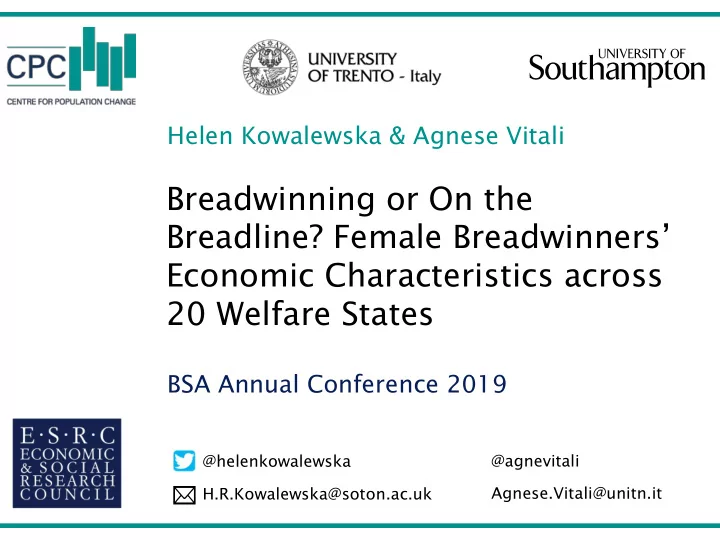

Helen Kowalewska & Agnese Vitali Breadwinning or On the Breadline? Female Breadwinners’ Economic Characteristics across 20 Welfare States BSA Annual Conference 2019 @agnevitali @helenkowalewska Agnese.Vitali@unitn.it H.R.Kowalewska@soton.ac.uk
From male breadwinners to dual breadwinners… Policymakers and academics promote a ‘dual - breadwinner’ (DBW) family model (e.g. Esping-Andersen et al., 2002; European Commission, 2013; Hemerijck, 2013) . In reality, the male-breadwinner (MBW) and ‘one -and-a- half’ male - breadwinner (1.5 MBW) models persist (e.g. Lewis et al., 2008; Hook, 2015) . ‘Pure’ MBW 1.5 MBW DBW FT empl. male + Man and woman FT empl. male + PT h/wife (lower- share breadwinning empl. woman (Anglo- educated in S. (Scandinavia and Saxon and Continental Europe) highly-educated in S. countries) Europe and US)
…To female breadwinners? Not considered in social-policy research, which assumes men in couple-households are full-time employed (Hook, 2015). Our research contributes to addressing this gap by examining the economic characteristics of female breadwinners. Data : LIS Wave 10 (~2016) or 9 (~2013). Sample : Heterosexual co-residing couples with/without children; 18- 65 years; neither partner retired, in education, or disabled. Monetary amounts expressed in US$ 2016, transformed using the Purchasing Power Parity and a deflator. To assess whether observed income differences between FBWs and MBWs are statistically significant, we use two-sample t-tests on the difference between two population proportions/means and Wilcoxon rank-sum tests for the difference between two population medians.
We identify two ‘types’ of female breadwinner, stratified by class % of FBWs who are highly educated 100% 75% 50% Pure FBWs: 25% only the 0% woman works 1.5 FBWs: Median disposable HH income, 2016 US$ woman $50,000 works FT, $40,000 man works $30,000 PT $20,000 $10,000 $0
‘Pure’ female breadwinners: ‘on the breadline’ Median disposable household incomes, 2016 US$ $60,000 $50,000 $40,000 $30,000 $20,000 $10,000 $0 DBW (m+f work) Pure MBW (only m works) Pure FBW (only f works) N.B. Solid colour indicates income differences between male and female BWs are statistically significant
But ‘pure’ female breadwinners earn significantly less as individuals than MBWs Median labour income of breadwinner, 2016 US$ $40,000 $30,000 $20,000 $10,000 $0 Pure MBW Pure FBW N.B. Solid colour indicates income differences between male and female BWs are statistically significant
Pure FBWs are more likely to be ‘emergency’ breadwinners Compared with pure MBWs, UK data pure FBWs: - Work fewer hours - Are less likely to be in managerial positions - Are more likely to be in elementary occupations Mean hours 34 43 worked/week Previous research suggests male job-loss is associated % in managerial/ 29.1% 35.8% with a rise in female Professional occs breadwinning - especially among lower-educated couples 13.8% % in labourer/ 8.2% Elementary occs (e.g. Dotti Sani, 2018).
One-and-a-half female breadwinners are doing better… Median disposable household incomes, 2016 US$ $60,000 $50,000 $40,000 $30,000 $20,000 $10,000 $0 1.5 MBW (m works FT, f works PT) 1.5 FBW (m works PT, f works FT) N.B. Solid colour indicates income differences between male and female BWs are statistically significant
But, as individuals, 1.5 female breadwinners earn less than 1.5 MBWs Median labour income of breadwinner, 2016 US$ $45,000 $40,000 $35,000 $30,000 $25,000 $20,000 $15,000 $10,000 $5,000 $0 1.5 MBW 1.5 FBW N.B. Solid colour indicates income differences between male and female BWs are statistically significant
Gender inequalities in secondary earners’ labour incomes Median labour income of secondary earner (i.e. non- breadwinner), 2016 US$ $20,000 $16,000 $12,000 $8,000 $4,000 $0 Woman in 1.5 MBW Man in 1.5 FBW N.B. Solid colour indicates income differences between male and female BWs are statistically significant
Implications Rather than reflecting women’s empowerment, ‘pure’ FBWs are • poorer and potentially breadwinners by default. Breadwinning will remain a gendered opportunity without broader • policies to address gender inequalities beyond employment rates (e.g. combatting discrimination in workplaces). Differences between pure and 1.5 FBWs suggest integrating the • female-breadwinner category into comparative social policy literature can illuminate how welfare state reduce or potentially reproduce stratification along gender and class lines. ‘Pure’ MBW 1.5 MBW DBW 1.5 FBW ‘Pure’ FBW
Centre for Population Change Find our more and contact us Web: www.cpc.ac.uk Email: cpc@soton.ac.uk Tel: +44 (0)23 80 592 579 Twitter: @CPCpopulation Facebook: CPCpopulation Mendeley: CPC Population
Recommend
More recommend